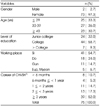1. Chung YS. Salt intake and dietary factors associated with salt intake in Korea. Catholic University;2006. 59–71. MS thesis.
2. Geleijnse JM, Kok FJ, Grobbee DE. Blood pressure response to changes in sodium and potassium intake: a metaregression analysis of randomised trials. J Hum Hypertens. 2003; 17(7):471–480.
3. He FJ, MacGregor GA. Effect of modest salt reduction on blood pressure: a meta-analysis of randomized trials. Implications for public health. J Hum Hypertens. 2002; 16(11):761–770.
4. Jang MS, Lee JM, Baek SY. Analysis of training needs with roles in college & university foodservice dietitians. J Korean Diet Assoc. 2005; 11(4):462–472.
5. Jeong YS. Salt intake and dietary factors associated with salt intake in Korean. Catholic University;2006. 59–71. MS thesis.
6. Jung EJ, Son SM, Kwon JS. The effect of sodium reduction education program of a public health center on the blood pressure, blood biochemical profile and sodium intake of hypertensive adults. Korean J Community Nutr. 2012; 17(6):752–771.
7. Kim SB, Yoon JS, Kim KW. Implementation and evaluation of nutrition capacity training program for dietitians and related professionals working at customized and home visiting health services. Korean J Community Nutr. 2014; 19(1):71–83.
8. Korea National Statistical Office. The report of estimated populations in future. 2006. cited March 20, 2012. Available from
http://www.kostat.go.kr.
9. Korea National Statistical Office. Annual report on the cause of death statistics 2010. 2011. cited March 20, 2012. Available from
http://www.kostat.go.kr.
10. Lee EJ, Han KS. The analysis of education needs of dietitians and cooks according to the type of hire and educational background in contracted foodservice management company. Korean J Diet Cult. 2000; 15(4):241–251.
11. Marshall TA, Stumbo PJ, Warren JJ, Xie XJ. Inadequate nutrient intakes are common and are associated with low diet variety in rural, community-dwelling elderly. J Nutr. 2001; 131(8):2192–2196.
12. Ministry of Health and Welfare. Korea health statistics 2010. Korea National Health and Nutrition Examination Survey. 2012.
13. Ministry of Health, Welfare and Family Affairs. Manual for visiting health services in 2007. 2007.
14. Ministry of Health, Welfare and Family Affairs. Manual for visiting health services in 2010. 2010.
15. Moon EH, Kim KW. Evaluation of nutrition education for hypertension patients aged 50 years and over. Korean J Community Nutr. 2011; 16(1):62–74.
16. Padwal R, Campbell N, Touyz RM. Canadian hypertension education program: Applying the 2005 canadian hypertension education program recommendations: 3. Lifestyle modifications to prevent and treat hypertension. CMAJ. 2005; 173(7):749–751.
17. Park JA, Jang KJ. A Study on elementary school dietitian's status and recognition of nutrition education in Incheon. Korean J Community Nutr. 2004; 9(6):716–724.
18. Park TS, Lee KY. A study on the sodium and potassium intakes and their metabolism of university students in Korea. Korean J Nutr. 1985; 18(3):201–208.
19. Park YS, Lee HY, Kwon YH. The relationship of functional health status, satisfaction of customized home visiting healthservice, and quality of life in vulnerable elderly. J Korea Academia-Industrial Coop Soc. 2011; 12(11):5071–5078.
20. Park YS, Lee JE, Seo JS, Lee BK, Lee HS. Nutrition education and counseling. 3nd ed. Seoul: Kyomunsa;2010. p. 3.
21. Park YS, Son SM, Lim WJ, Kim SB, Chung YS. Comparison of dietary behaviors related to sodium intake by gender and age. Korean J Community Nutr. 2008; 13(1):1–12.
22. Roedinger HL, Rushton JP, Capaldi ED, Paris SG. Psychology. Boston: Little brown;1984.
23. Son SM, Huh KY, Lee HS. Development and evaluation of validity of dish frequency questionnaire (DFQ) and short DFQ using Na index for estimation of habitual sodium intake. Korean J Community Nutr. 2005; 10(5):677–692.
24. Son SM, Park YS, Lim HJ, Kim SB, Jeong YS. Development and evaluation of validity of short dish frequency questionnaire (DFQ) for estimation of habitual sodium intake for Korean adults. Korean J Community Nutr. 2007; 12(6):838–853.
25. Whelton PK. Epidemiology of hypertension. Lancet. 1994; 344(8915):101–106.
26. Won JH, Park IS. Oral health knowledge and behavior of visiting health care personnel. J Korea Academia-Industrial Coop Soc. 2010; 11(7):2459–2467.
27. Yang JH, Lee HY. Task analysis and education need of dietitians in the contracted business & industry foodservice. Korean J Community Nutr. 2010; 15(1):124–136.
28. Yang JK. Effects of nutrition education program for elderly with hypertension at the public health center: focused on individual energy intake. Chonbuk National University;2009. 644–45. 73–74. MS thesis.
29. Yim KS. The effects of a nutrition education program for hypertensive female elderly at the public health center. Korean J Community Nutr. 2008; 13(5):640–652.
30. Yun SH. A study on estimating sodium intakes by food frequency questionnaire (FFQ) of adults in the Jeonbuk province. Chonbuk National University;2007. 26–37. MS thesis.





 PDF
PDF ePub
ePub Citation
Citation Print
Print







 XML Download
XML Download